ORDINIS HELENUM:
SUPERHELENA PART TWO
Continued from part
one. Footnotes numbers 21-30.1
Comments on
the Legend of
Saint Helena
of Westgothia
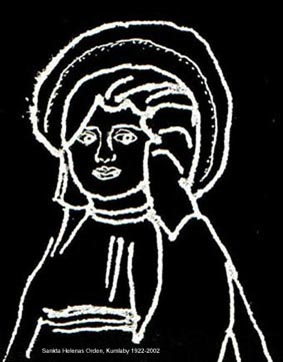
"Helena
effects my Mysticism
in Silentness now
and in Revelation then.
I'm leaning on Helena,
caressing her duly.
My earthly mother gave me Death;
my true mother, Helena, gives me Life.
She possesses Holy Spirit,
Silence and Wisdom".
***21...In the morning of the fourth day of the conveyance the carriers passed the shallow ford of the rivulet, which runs from Womb... "the carriers halted on the road for Thanksgiving in the appropriate hour, whereby instantly a new fountain bubbled up, which until the present day is called the Source (Fons) of beatific Helena", (and this was miracle #4). An oratory was soon erected over the well for to protect the same. This oratory became a chapel where wayfarers did their devotions, and where local ceremonies took place. It had some altars, figurines of saints, mural paintings, niches and vaults. Bishops Nicolaus and Sigge promised a reduction of Purgatory-time for those who visited the source and the oratory here - signed on 12/7.1373 and on 23/10.1425 respectively. In 1759 one used stones from the oratory for the construction of the bridge lying some 10 yards away. In 1956 the well was rendered neat, and a small monument was set up...
21.1: THE ORATORY
and its WELL:
Varieties: A)Some claim prooflessly that the site of this well had been
employed by the heathens in the 5th and 6th centuries - it had been a
major pan-westgothian venue. That's of course impossible, since the well
did not come to be until in 1140!
B)The well near Skovde is suggested to have broken forth there as a result of the revengers having dug down Helena's body on the very spot.
C)This same well is suggested to have been the position both of her cloister (O.Praem.) and of her martyrdom.
D)The lesser of the two churches that she financed the renovation of, is suggested to have lain beside this source and therefore not at Gotene (a corrupt idea; Gotene is absolutely right, and this Oratory wasn't built until after her funeral!).
E)"Many generations of swedes and people from elsewhere in Norden journeyed as pilgrims to the chapel at Saint Elin's Well". In 2001 on 31/7, one of St. Helena's feastdays, there was a major honorary manifestation for her; 'twas seriously meant as an acknowledgement of her divine work in the 12th cent..
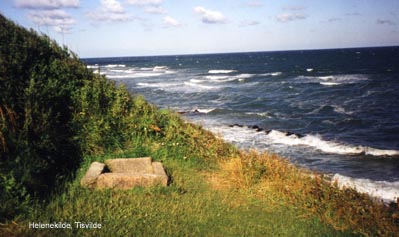
21.2:Honestly, there are only three doubtless helenic wells in Sweden, namely the one at Gotene and the one at Lyngsio and the one at Skovde - all others are uncertain in one way or the other. These three and Her well (Kilde) at Tisvildeleje/ Denmark are the definitely holiest sites on the northern hemisphere! The wonders that occurred at her wells can be compared to John.Chapt.5 - an angel climbed down periodically into the pond, stirring up the water. The one who was the first to get into the water, after the stirring started, got healed from any kind of disease. The Oratory-well of today lies a couple of yards off its original spot, on a shelf between the steep brink and the Wombo Rivulet - unfortunately its Temple is invisible since 1759, but it's grandiosity and power are fully sensible - beneath the old country-road-bridge over the rivulet within the premises of the Panzer-Regiment of Skovde, and its address is Pansarvagen 541 52 Skovde. (In 1999, 21/9, one detected maybe the original well within a ring of small stones. Its width is only 21 x 42 cm. In April 2001 the bridge was partly dismantled during the process of re-cementing the same).
21.3:The Oratory is called a "Desolate Chapel" on a map of 1816, and the well an "Offering Well", both situated north-east of the ford. The underground foundations were uncovered in 1954. In 1955 the stepway to the waterhole was built. A neat monument was set up in 1956 above the waterhole, and two signs are there. A stone's throw (some hundred yards) southwest of the ford, within the area of the modern military garages, close to the west side of the prior trunkroad, there Kaellegaarden used to be - a sigular farm. 'Twas firstly mentioned in 1540 (as Hargustorp); again in 1611 as Kellegardenn. In literature the village here, which never existed, is a confusion with the village of Hene.
21.4:The steep brinks on both sides of the rivulet at the ford have been levelled some, where the trunkroad is drawn across, so they slope less now than they did in the 12th century. To the east there was a bog where offerings were made, as an assurance of being able to gain a lucky and undelayed return to Skovde. Into the well itself one offered coins and metal pieces as lately as during last century - (no, still offered coins are found in it) - and a lot of small crosses used to stand around it. The surroundings would be bright and beautiful, having flowering arbours and huge foliate trees. The protestants filled the well once with stones and dirt, but immediately it was revivified, pouring from under a boulder, which used to be the south-east cornerstone of the Oratory.
21.5:The well was incorporated in the garden of a house, which stood there from the 1880:ies to the 1980:ies, and it was furnished with the stepway and draining-tiles. In days of yore its water would be cold, fresh and health-bringing, like in 1757 when "the fine water keeps streaming out by a stone under the gravel from the crumbling walls" - today umpteen kelpies couldn't make one drink its greenish, slimy water - but!: still the water is holy. The Oratory-floor measured some 40 square yards (or it is 9.6 x 5.4 m). The Oratory is already partly described - furthermore: It had an apse on the east gable, centrally having a circular fenestration; its portal was on the north side, toward the brink. (Niches for altars of saints can be seen on either side of the triumphal vault in the partly ruined 12th cent. church of Borrie, conserved in 1928, see p.892, for educational reasons). The well was INSIDE - the water was gathered in a natural cauldron before floating out under the west gable-wall through a slot. One single fenestration, shaped as the Ace of Clubs, was on the south side. Outside, over the slot of the west gable (Hes.47:1), there were two decorative lists of stone reaching up 2 yards, and over these there was a fenestration, shaped as the frontal outline of a flying bird. The water continued/ continues meandering down to the rivulet ( - actually, though it might sound like a joke, this water winds up in Lake Waner, whence Mariestad and Lidkoping get their drinking water; and it continues downstream the Gotha Canal & River, whence Gothenburg and Molndal get their water, so the populations there drink holy water without knowing it!; Hes.47:8-9). A drawing of this well, uncovered during investigations 29/9-99: 21/1697, and texts concerning this 21/1860-62. Drawing of the whole site 21/1886-89; summary 21/1900. The alleged "real" waterhole measures 29 x 44 centimetres only; 33 cm deep; sides strengthened by stones only at its orifice. The oratory is claimed to have measured 9.6 x 5.4 yards, judged by its supposed foundations having cemented joints. The cottage that had been built in the 1880:ies over the well, was torn down in the 1980:ies. The couple, who had lived in it 1953-68, witness that they had sensed a protectoress dwelling in their house, and sometimes they had heard some invisible one turn the door-knob and enter the cottage - they and their pets got used the phenomenon.
21.6:This Oratory was not unique in having an indoor-well. Conf. Sanga Church near Solleftea, which well was "turned off" in 1534, and now is covered by concrete; and Vange Church at Brunna/Upsala - 'twas detectable under the floor up to last century. And Aaseda Church since 12th century; and the Crypt of Lund's Cathedral - its well was the reason for building the church just there. And the portico of the Church of the Holy Cross at Dalby, built in 1120, was initially a baptismal chapel. In its north-east corner folks still keep offering into the indoor well.
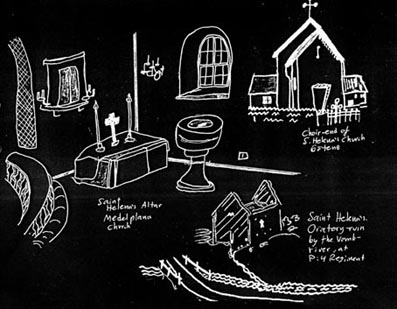
21.7:The stones from Helena's Oratory were reused for building the bridge beside it, and for rebuilding Her Church in central Skovde after the Devastating Fire in 1759, and nothing can be seen above ground-level of the Oratory since then. The phoney foundation of stones that is there now, is connected to the mentioned, recent house. Fortunately, during the 1750:ies, the Oratory was drawn by an artist and historian - it was roofless, but its walls and gables were still standing. A model of this ruin is made by and shown in Skovde Museum - a crucifix is posing on its altar... I'd love to tear that bridge apart in order to recover the Holy Stones from Her Oratory!
21.8:In Syria, more than 2000 years back in time, the Mandeaen religious group started practising rituals in living water, and by the streams they erected small, plain oratories like this one by Wombo Rivulet. Vilhelm Bang describes waterbound ritualism of Scandinavia before 1000 AD, and this corresponds prettily to that of the Mandeaens.
21.9:Brigida of Kildare had a mythological predecessor, bearing the same name, from whom she has inherited a lot of qualities and assignments. Constantine's mother Helena had too a (more or less) mythological predecessor bearing the same name, from whom folks posteriorly have transmitted attributes and stories to the emperor's mother. And hasn't, for us living around Gotene & Skovde, our Helena become a replacer of mythological Froja? And haven't pilgrimages and purgatorial easements become substitutes for earlier religious acts in our county. The actions of a believer is really not a reminder of what was performed and has happened a long time ago, but it's rather a RENEWAL. Celebrating the Lord's Supper is comparable to filling your car with petrol (not our idea).
21.10:Let your imagination work: Each springtime our Helena gotta be brought out of sleep of her long hibernation. We who love her, want her to come back here again from afar...
-"I take a nightly ride across wet mountains (Mount Billing is a very wet mountain) for to fetch her".
-"Listen, it's my highly valued one, he's a-ridin' here over mountains and hills. Lookit, now he's a-standin' there behind our wall tryin' to see me thru the windows, a-glancin' thru the ribbin' ".
-"Arise, beautiful Helena, my beloved one. Come. The winter's gone. The rain has ceased and it's now over yonder. One sees meadows aflame with flowers. 'Tis the tide of everything singing..."
21.11:In order to free Helena, her dominator gotta succumb! "I, who awaken Helena, is awarded by being crowned at the Holy Well, and thereby I'm united with Her in a genuine and supernatural wedding". Wow - this was redetected UNAWARES by GL in the 1950:ies, 'cause what he really described was how a Messenger of God descends thru the toll-zones of the archons down here in order to save me or you, her or him, enlightening us and enabling us to return to God's real Realm! His redetection re-tells at the same time the gnostic story of Simon the Magus and Helena of Tyrus and their constituting the prime, perfect, spiritual couple... Now, the basis of Faith is no-way a heritage, but contrarily 'tis a life in community with the Holy Trinity and with his angels and saints (and with co-believers, if any exist). The life-of-Faith has to prove its power through repeating christian or gnostic or manichaean predecessors' deeds over and over.
21.12:Lastly: At this here Helena's Well one gathers yearly on the 31/7 and listens to a few lines on our saint. Then one walks from there to Her Church (the Elinsvandring) to attend a service - in connexion to which one uses a contraption to lift up the lid off the choir-floor and shows the stairway down to some ruined and not very old crypts.
AND
21.13: A FOREIGN ORATORY: Yea, the correct term is Oratory, see its medieval documents! This means a small chapel for private prayers and devotions, often a part of a bigger church or of a private residence (Latin: Oratorium). Here these were mostly chapels-of-ease, extrachurches in a parish. Helena's Oratory was reported in 1373 to be renovated! but it was isochronous with the 12th-century-churches of Forsby, Hene, North Kyrketorp, Ryd, Skovde, Suntetorp and Womb. In an ecclesiastical document of 1425 another oratory is mentioned in the vicinity - Birgitta's Chapel - 76 years after she in real life had visited the site and 34 years after her canonization. It lay approximately underneath (literally) N:r 37 Valle Street of today. After a competition, which must have gone on from before 1425 until after 1495, our Saint outwitted t'other one, who came from beyond Lake Wetter: "Birgitta has withdrawn to Wadstena in Eastgothia duly - hail Helena, regina of Westgothia!". (Well, one of the cemeteries now of Skovde and its modern chapel are compensatorily named after S.Birgitta).
AND
21.14: S:CONVIVII S:ELENE IN SKODVE: From the Middle Ages up to last century there was a S.Helena's Guild (brotherhood) alias Convivium (jovial group & hall) - a quasi-secret association of tradesmen firstly; later on 'twas a secular club for having parties in the open air on Champs d'Hélène (Elinemark; nowadays the parking infront of the public Baths and the Local Radio Station are there, and this is where the Sports-Arena is being eretced in 2001) on Her Days. Oaken baulks from the ancient Guildhall have been found in the field on the east side of the Oratory & Well, where the opendoor activities were held in the first place. A modern Sankta Helena Gille has been founded in Skovde, to arrange the Elin's Market yearly in the garden among the red cottages beside Helénsgarden - this wooden house from approx. the 1690:ies was about the only building in all town that wasn't burned down by the Fire of 1759.
21.15:One copy of the badge of the old guild was preserved by the highpriest of Hedemora, Nikolaus Rabenius*, bearing the text of the headline above. Helena looks honestly like a man of Dalarna County, sitting on a log with her legs crossed obliquely to the left. She holds her left arm akimbo, whilst her right hand squeezes a staff, one yard tall, which looks like a thin taper with a flame at its top (S.Helena's Fire?). Underneath there's a bigger flat stone resting upon a smaller one. Her clothes and her hair-cut look typically 18th century-like. (Nota bene: No, the Guildhall didn't occupy the south-east corner of the graveyard - on the map of 1687 that site is empty. In 1759 there was a warehouse of stone, evidently torn down before 1862.). *{Born at Raby/ Tortuna 27/10.1648; ordained a priest 9/2.1673, and worked 1676-91 at David's Munkenthorp; married 3/9.1676 to Christina Buskagrius; appointed a royal priest 29/8.1690 in Stockholm; defunct 7/9.1717}.
***22...If the 1:st of August were a Sunday, then the fifth miracle did occur on Thursday the 5:th: Helena's body was rinsed over the big one-piece boulder on the cemetery (which today is the park outside S.Helena's Church in Skovde) for her funeral. This boulder used to be the pagan outdoor altar at the hub of a circular Holy Camp (that is what the name of Skovde means) of the demigoddess Froja - our ex-collateral of the goddess Helen of the pre-Greek culture - surrounded by a low wall of natural stones. Now, after Helena's body had been rinsed, this boulder divided itself in such a manner, that the part over which her holy blood had dripped ROSE, to render it impossible for anyone to trample on it - whilst the other part remained lying. This pagan altar (to put it in another way) couldn't stand Helena's holiness, and its division marked the cracking-up of paganism and simultaneously the Victory of christianism hereabouts. The greatest bishop ever in Sweden, Brynolf #1 Algotsson, swore that God Zebaoth through this miracle notified that Helena's Faith was that grand during her lifetime that this miracle realized the words of Matthew 17:20. We said that the boulder remained in the way described for a maximum of 111 years, and that a number of wonders and auspices did happen here as long as the place was kept in due reverence.
22.1: THE RINSING-BOULDER (from rinse = to cleanse with water). Varieties: When Helena's holy body was brought in on Skovde's Cemetery and was carried over a boulder, this boulder divided itself in two halves. And one of the halves, over which the blood from her wounds did coagulate (an incredible danish story caused by a crazy translation of the latin verb), was arisen by an invisible hand, but the other half, which did not stop the flow of blood, remained lying on the ground. (The first half seems to have been honoured by this arising whilst t'other one was condemned, like the Serpent of Eden, to crawl in the Dust. Or it represented the gnostic Hestos). The Rinsing-Boulder was not cloven before this fifth miracle, but whole. After the miracle it was still not turned into a "Cleft Stone" - bishop Brynolf #1 and the legend do clearly describe how the boulder behaved.
22.2:Cleft Stones in Sweden were used by women for superstitious purposes as to fertility - though the Rinsing-Boulder never was one, it still was used, during the eleven decades it was posing as mentioned, by pregnant women in such a way, that they walked three turns around it "to make sure that they'd get healthy and many children".
22.3:The R-B was gone already during Brynolf's childhood (1240:ies or 1250:ies). Its behavior has been compared to Matthew 27:51 "The Earth shivered, the rocks cracked..." At least there are three additive details on its further destiny to relay:
A)The half of it that stood up, fell by itself when Ab.Angermannus and his "superheroes" approached it in 1596 - no wonder that it fell!
B)It's told that the same "he-man" moved the R-B to the Market-square, 100 yards to the west in central Skovde, and set it down by a kind of Judges' Ring (ring of boulders, believed to have been used in outdoor trials), and in 1661 it once again got blooded - this time through an execution!
C)The R-B (or a couple of flat stones accidentally invented by a journalist in the 1960:ies) were maybe moved to the Ahlanderian Site (ex-Strokirkian Site), where they got overbuilt in 1850 by a shed or stables (now torn down).
22.4: Lastly a fathomless reflexion on the R-B: When S.Helena was carried into this holy enclosure, where the church of the future Skovde Town was under construction, the "hargh" broke - the Stony outdoor Altar - on the future cemetery, because Helena is sacred and christian, and now the power of paganism was broken here. Helena's body was lifeless, but She Herself was transformed into the Powerful Saint of Westgothia. The R-B, called a Cleft Stone by some, was the altar of the demigoddess Froja. Its enclosure was really yclept a "vi", which word is the second syllable of Skodve, now Skovde (not a joke!). There was a costume to carry a relative, who had died, to the holy grove, which was not meant for normal human activities, and it seems like carrying Helena from Gotene to the ex-grove of Froja at Skovde, where the church was being built, was a relic of this custome. (Parallelly there was a costume of dipping a defunct into a holy well before the funeral, and in Helena's case one well broke forth where she died, and another where her holy body was set down). According to this theory, Helena's Church now rests upon Froja's outdoor holy enclosure - which maybe already had been overbuilt by the mentioned fort.
AND
22.5: "...REVERENCE DUE TO THIS PLACE." Politics: Pope Alexander III forbade the worship of the uplandic leader namned erik, and this heretic worship seems to have caused Al to thenceafter take full control of canonizations. The first papal canonization though had been carried out in 993 when Ulric was subjected to this rite. This erik had a son of his own ilk, Karl eriksson, who murdered the honourable king Karl Sverkersson in Castle Naes on Visingso 12/4 1167 - Karl Sverkersson was a promoter and propagator of S.Helena's Cult. Thereafter Archbishop Stephanus of Alvastra started to suffer from reduced possibilities in Upsala to work duly. He didn't make Bengt the Good (read: the Evil One) a bishop, but instead Bengt the Evil One was the bishop that erik chose, without consulting the people of Westgothia. This false bishop, BEO, worked against the Sverker Party and the Helenic Cult and he succeeded in wiping it out in Westgothia. It's of course totally out of the question that BEO had inaugurated Medelplana Church to "Elin" - a mere Janssonian invention! BEO helped the anticatholic erik-party, and helped it to create a phoney erik-tradition of Eriksberg. But thanks to God the Helenic Cult survived in Eastgothia and in Denmark and Scania, which was the county of the Sverker Party. The OSB-Cist.cloister at Varnhem cajoled the erik-party and filled its church with phoney royal graves.
22.6: Eskil the legislator, married to the granddaughter of erik, did of course not support the Helenism either. The "Folkungar" including Birger jarl were also detrimental to the Helenic Cult. Yet, Alvastra was indeed an indispensible lieu for the Helenic Cult. It served as an exile and a hothouse for this. The bishop of Scara 1358-86, Nicolaus of Kolland, and king Magnus Eriksson were on the same, right side. Magnus was strongly interested in Helena, and during his great government Skovde grew into a new Helenic Centre. In 1346 he and his beautiful belgian wife Blanche gave money for the ecclesiastic clothing of Sanctae Aelinu Kyrkiu in Skovde. God bless the Sponsors of Helena!
***23...We arranged quite magnificent a funeral, and Helena got buried in her first sepulchre, the one she herself had designed, in the portico mentioned, until future alterations. (As a result of misunderstanding some folks claim that her coffin was set on a "cracked flat stone" there inside, and recently there was a rumour of that these pieces were lying under a shed on a backyard in central Skovde. They tore the shed down and found nought). S.Helena's Church in Skovde was not at all completed at this time (1140) - not even its walls of stone-cubes - and all around it the beginnings of the town were under construction.
This first church-building was very small and simple; all rectangular except for the apse; it had no bell-tower. It was placed over the ruins of a fort, of which one square turret was retained as mentioned, within the pagan circle. After 1164/65, when Helena had gotten canonized, the church was dedicated to her, and it was rebuilt totally - now much bigger, having the exactly same architecture as its contemporary sister-churches of Vreta and Linkoping (none of these three buildings exist any longer!), and 'L'église de Saint-Hélène' in Skovde became a collegiate church. Description of these first two churches, see 23/2036-37. For a short time (1160 plus some decades?) a Premonstratensian cloister existed at Skovde, where the hall of gymnastics/ Helena School now is standing - both "canons" and an "abbess" are put in connexion to it. The real heydays for the sake of Skovde town didn't come until 300 years later. Not an atom remains of the two first church-buildings, so all later descriptions of Helena's Church refer to wholly other buildings. (Conf. the successional domes of Linkoping).
"The very old church, dedicated to Helena, is distinguished as much by its precious architecture as by its dimensions. One regards Helena as its foundress, and it's built solely with cubic stones except for the foundation of its tower - it was erected towards the end of the 15th century or at the first years of the 16th. In 1530 its greatest bell was removed from the church..."...
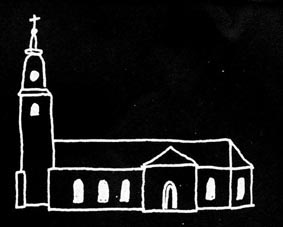
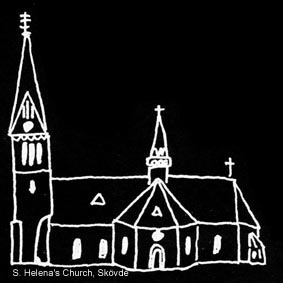
23.1: CUBIC STONES: No, Skovde's Helenachurch isn't built completely with cubic sandstones - bricks are used, as well as flat limestones lying in layers.
23.2:PORTICO: "An original arcade gallery from ~1150 between the tower and the nave can be studied in the church of West Sallerup, {Saxulstorp in 1201}, near Eslov" - the Skovde-one existed obviously in the 1280:ies. (This scanian church was repaired 1947-53, but two pillars do not make a gallery: "...both pillars, or small columns, which decorate the west side of the nave, were made by Martin the Master Stoner too. Originally they united the nave and a balcony for the aristocracy... ...and the old small columns of the oldest days of the church were brought into reappearance"). San Chrysogonos' basilica near Piazza Sant' Apollonia in Rome, and Sant' Elene church in northern Italy, have real porticos, and the latter one might be studied in order to understand how Skovde's helenic church looked like during Brynolf's lifetime.
23.3:HELENA's TITLE: Helena is entitled the Saint of Westgothia at first and then the Patroness of Sweden, but never ever the Saint of Scara Diocese. (This latter was founded in around 1050 and embraced maybe the Linkoping Diocese too until ~1120; and the Wexio ditto until the 1160:ies; and the Karlstad ditto until 1557; and the Gothenburg ditto until 1620).
AND
23.4: A SURVIVOR: As recently as in the 1730:ies there was a catholic Incensory preserved in Helena's Church in Skovde.
***24...Seven other miracles took place within a short time after Helena's funeral, as a result of prayers, appeals and tears by those who came to Helena's Sepulchre in the Portico. One comes to think of the sick at the porticos of Bethesda; here we too had (and have) a pond - infront of the apse. Also did superstitious actions take place - around the divided boulder. The Helenic Miracles were: 6>One person got recovered from muteness. 7>One person regained his hearing. 8>One leper and 9>one cripple got well and sound. 10>A stoner, who was squaring stones for the church, was attacked by four horsemen - he got impossible to wound with their swords because he cried to Helena for assistance. The horsemen then killed an approaching man. The stoner witnessed that, and the horsemen turned anew towards the stoner, but immediately he turned invisible to their eyes!
Miracle 11>: Brynolf #1 was busy crossing Lake Wetter from the east (13/8 1288) when the waves got tall and raving and the wind turned to blowing strongly from the west. He feared he'd either drown or get flushed back unto the shores of East Gothia, where the king's men were waiting for to arrest him. Brynolf had started to renew and reactualize the Holy Cult of Helena six years earlier, but he'd quit and had derailed from her lovely line - he now had but one option left: To cry to Helena! He did and he repented and he promised her to work for her again - to write her a Church Mass - if only she'd save him. She forgave him, and all on a sudden the weather got optimal, and he arrived happily at Westgothia and soon thereafter at Her Church in Skovde!
Miracle 12>: Monks removed Helena's reliques from Skovde one night, in order to save them from the "reformation", and transferred them to Denmark. (This is just one of the many versions of how Helena came to Denmark, and it's neither true nor possible. The truth is that Guthorm Jarl, one of the top politicians and heroes here of the 12th century - he worked for king Sverker's Party in Eastgothia and also in Sjaelland/ Denmark - he named one of his daughters Helena after "Saint-Helena of Skovde", and he and this daughter and her two children Knud-of-Reval and Ingeborg-of-Kalundborg, they all perpetuated the Helenic Cult in Eastgothia, Scania and Denmark. The cult survived in these regions even when it had been forgotten i Westgothia! At Tisvilde(leje)/ Sjaelland Helena's Well (Kilde) and Oratory-ruin (the so-called Grave) and Holy Cloven Stone (Kildeblok) are still used religiously, superstitiously, for tourism and for the excitement, and there's the modern Sankt Helene Centre).
The Helenic miracles on Sjaelland were that when Helena (dead or alive according to different versions) landed on the Danish shores, the steep brink cleft itself to create a good pathway up. Then a well broke forth with healing water, and thirdly, on carrying her body towards the church of Tibirke, it got so heavy for supernatural reasons that the carriers had to set her down and bury her on that very spot (see more among the following comments and in our Tisvildeleje Homepage).
Helena Guthorm's-daughter, mentioned just above: - her two children erected after 1230, where the alleged Helenic Grave is, the Oratory of Saint Helena in Tibirke parish.
24.1: THE MIRACLES: One informer mumbles that Helena, during her lifetime, never was able to do miracles - yea, God did let her do such! - but posthumously she was. Anyroad, those among the miracles which hadn't been written down, were already during bishop Brynolf's lifetime forgotten. Still he claims, that there were more known miracles than he had included in his liturgical helenic text. Her Healing Speciality, according to almost all witnesses in Scania and Denmark except for what is listed here, is Giving the Sight Back to People! - literally and spiritually. In Skovde too several blind persons got cured; cf below under 25:6. Then again, apparently Helena was able to blind her enemies too - the Stesichorus-incident is one exemple, and the scornful priest in Sjaelland is another. And one receives strength and health from staying the night on Helena's Grave (Tisvildeleje) or at her wells - or from touching her monuments, since power from them transfers to the believer, and we know it works. The phenomenon is called Incubation - some call it quackery and gull-catching, though.
24.2: THESE
ARE THE MAIN WESTGOTHIAN
HELENIC MIRACLES AND THEIR LEGENDARY
DATING:
I: "...the mother of Helena, the night before Her birth, had, they say,
received a Revelation, when an Angel had said concerning the expected
child: 'She will carry the golden crown of saints'." (1102).
II:The transfiguration of Helena's three loaves into stones (1136).
III: "Just as she was about to leave her home, a small bird flew through the open window into her room, and laid itself to rest in Helena's lap. She watched with amazement that the bird kind of tried to stop her from leaving. But she did not want to be late at Mass (in Gothene Church), and eventually she arranged a nid in her room for the bird, and hurried off" (1/8-1140).
IV:The outbreak of the well where Helena was martyred (Sunday? 1/8 1140).
V:The recovering of a blind man's sight through Helena's blood (1/8 1140), see above.
VI:The outburst of the well near the ford of the Wombo Rivulet, whenas Helena's stretcher was set down (Thursday? 5/8 1140), see above.
VII:The arising of one half of the Rinsing-Boulder, for the protection of Helena's Blood (5/8 1140).
N:rs VIII - XII occurred from Saturday? 7/8 1140 and a little onwards...
VIII:"Whenas a certain one, who had been mute since his birth, had been praying (Joh.4:24) and weeping by the grave of the Martyr perseveringly, he was quickly given the service of speech by God, and the former silence did set new words free".
IX:"Thereto there was a certain deaf one, who had had to stand that much inconvenience of his deafness, that, unless someone shouted up his ears, he didn't perceive any sounds. He implored thus the Martyr, who turned her ears to the clamour of his calls, and she restored the hearing to his deaf ears".
X:"Moreover a certain leper was conveyed to the grave of the Martyr, where he persevered for a long time in tears, and, thanks to the merits of Helena, he was spotlessly mundified".
XI:"A certain one who kept limping, had implored the Martyr for help - he enjoyed being able to return to his estates merrily, with stretched sinews, straightened shins and strengthened feet".
XII:"It also occurrred that a certain weaponless and unguilty stoner ("lathomus") at the church of beatific Helena (at Skovde), was forced to dodge to enemies with unsheathed swords. Except for damaging his attire, they were unable to wound him inasmuch as he implored the Martyr for help. A few traces of the cuts, looking like scarlet threads, were visible on the skin, as if tip and tail of their swords had been blunt. As the same enemies realized that they could achieve nothing, they turned away into different directions from the stoner. Their swords withal they stabbed to death another one thereafter, who was approaching them. Consequently they turned around against the mentioned stoner, but were hence struck by blindness in such a way, that even if they had been in the same house, they couldn't have seen him..."
XIII:Helena calmed the storm to bishop Brynolf #1, whenas he, on the 13th of August in 1288, tried to sail across Lake Wetter, returning from his exile in Alvastra Cloister.
XIV:The group of helenic miracles in Denmark - Varieties: Helena was a pious, swedish daughter of a king, running away from Sweden. She was a widow, and came sailing on a stone and drowned off Tisvildeleje (or Saltbodleje, as the name was before 1560). Or else she got killed there and got thrown into the sea... But generally it's told as follows: On a flat stone one carried Helena's body ashore, 800 yards north-east from Saltbodleje. Pious peasants were to see to that she'd be buried in christian soil. The steep brink then opened up a cleavage miraculously, rendering it possible for the peasants to carry her up, and where they firstly set down her litter for resting, the well broke forth. It is today a water-hole, having sides strengthened by stones in a cleavage of the brink. And in the village, the modern Tisvildeleje, there is a grassy lozenge having an earthen upheaval with standing stones called Helene Grave. Recent investigations have proved that these are the remains of Helena's medieval Oratory. It was built shortly after the 1230:ies by Ingebourg of Kalundborg and Knud of Reval as a Temple for devotions to God and Helena of Westgothia, and for the reminiscence of their mother, who was named after our saint - Helena Guthormsdaughter. The two children were partly raised in the Castle of Saeby in the neighbourhood, before moving to Linkoping/ Eastgothia.
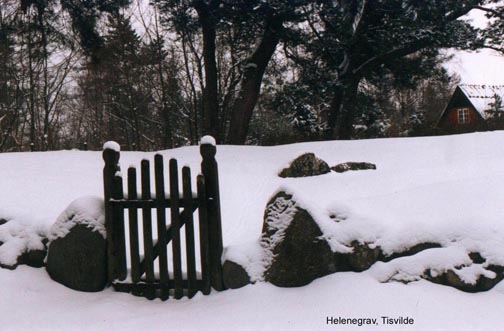
24.3:Helena's Well (Kilde) and her Grave (ruin) and the Kildeblok became a popular goal for pilgrimage, one of the three greatest in Norden after Skovde and Nidaros. As to the Grave, people who wish to get well, better have to go there on Saint Hans' Evening and sleep on the grassy lozenge all Midsummer Night - which unambiguously is the night between 23rd and 24th of June*. In a brand-new folder on S.Helene Centre you can read that one ought to fetch water off her well on S.Hans' Evening and thereafter drink it at Midnight on the Grave. Otherwise pilgrims take earth from the underside of the standing stones (cf the Hestos), and preserve it in minute bags. A wooden cross used to stand there, typically as to wells of Norden, and votive gifts were often left there. As to the well one has better drink from it 2/2 on the Candelmaesse, 30/7 (31/7) on Helena's Feast and on 29/9 (30/9) on Michel's Feast. Plenty of small crosses used to surround the well.
24:4: THIS
"MIDSUMMER-THING".
"Isn't it superstition to assume that exempli gratia Helena's Wells are
the most powerful during Midsummer Night? No, inasmuch as one's personal
experience clearly verifies to one that they are!, but one mustn't ascribe
this powerfulness to John the Baptist! but to the fact that this feast
marks the acme of the year; 21/6 is the longest day of the year and is
followed by the shortest night. It also marks the crisis of the year,
since thereafter the days start shortening. For human beings, profane
and religious ones alike, and for plants and animals, Midsummer is the
Epicentre of the Calendar. 'Tis a supernatural space of time, if one likes
it or not irregardless! (Cf 16:5 above)
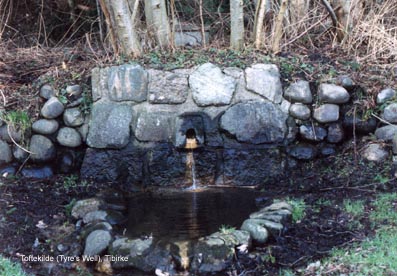
24:5: IS
THERE A SJAELLAND-LEBANON LINK?
Messenius claimed, as a joke we premise, that the old idols of Norden
had come from Middle-E, so there is a vague reason to ask: Is it a coincident
that there was a Helena of Tyrus (Tyre, now Sour), and that there is a
Helena of the parish named after Tyr (Tibirke), the old idol of Norden?
24.6: ON
THE NAME OF SKOVDE AND ON GOLD:
Our Skovde lies in Kakynd(1225), and was written the first known time
"i Skodwe" in 1281. Vi = holy lieu; Skede = camp, but then again this
syllable might have been Skot = the Wedge between the southern and the
northern halves of Mount Billing - the wedge is "shot" inwards whilst
the mountainsides shoot outwards according to an author. His alleged pagan
temple lay in Womb (= Corner), where the wedge starts to form a valley.
Olof Skot-King is maybe namned after Skot-Vi, and his notorious "Collis"
could be Elinmark's Kulle. That he minted coins on this hill is shown?
by the huge local finds of gold:
A)In 1904 more than 7 kilograms of gold were found at Timboholm in a heap of earth. It's criminal that this gold is kept in Stockholm - it ought to be preserved in the Temple of S.Helena! (The gold was found 100 yards south of an outbuilding of Timboholm in a morainal knoll of 25 diametral yards and a height of 1.2. There's a one yard deep central pit on it. Stones are surrounding the knoll).
B)In 1923 a golden bar was found under Vasa Street in Skovde. C)In 1930 at Risatorp, an arm-ring from the age of vikings was found, made of six twined strings of massive gold. D)In August 1937, 100-200 yards west of Helena's Church, a golden spiral was found, made in 450. E)In 1946 an arm-ring of gold was found east of Timboholm.
F)At Horsaas a golden chain with 2 rings has been found - (some chain!). G)At N:r 23 Alstromer Street on Elinmark's Hill a golden ring has been found. H)A ball of gold of 2 diametral centimetres has been found 200 yards north of Womb's Church near the Farm of the Golden Hill. I)300 yards south-south-west of Womb's Church 3 thick spirals of gold have been found, weighing 0.377 kilograms.
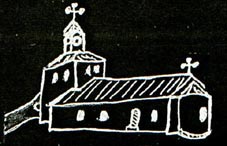
24.7:There are two other "skovdes": Ale-Skovde, first written Skodhwe in 1401. Kullings-Skovde, first written Skotwe in 1402.
24.8:In 1998, 29/5, there was a radio program on the subject of digging down gold and silver within one's premises: This was not just a pagan measure (older than the age of vikings), but also a christian. The mansion of a farm was built upon some precious metal, and on strategic places within the premises such was dug down in course of time. The owner bound a curse to the metal, so someone who tried to steal it would be punished. The metals had a smitting effect on the owner and his/her staff. Then these defined the borders of the estate; increased the interpersonal links within the staff. The metals were not supposed to be uncovered, ever. When the owner was on a journey, the metals were guarded by dragons or a black dog. Well, the enormously rich finds around Skovde prove the high status of the ancient inhabitants there - Helena's ancestors?
***25...One way or the other there are about 30 churches and chapels connected to S.Helena, and so are 4 altars, 1 churchbell and 23 wells in Norden...
25.1: CHURCHES
AND CHAPELS CONNECTED TO HELENA
ONE WAY OR THE OTHER:
"In Greece-to-be there
used to be
many sanctuaries consecrated
to Helena,
and one was dedicated to her
Sandals!"
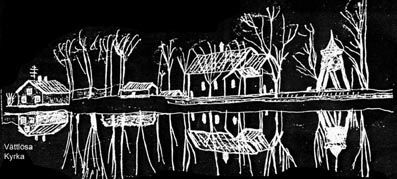
Wettlosa Church
I:WETTLOSA Church (existed before 1100, but was surely partly of wood in Helena's lifetime. It has had an apse and stone-relievoes. Mural paintings on walls and vaults, describing the legend of a saint. The relique inside the altar is still there). (Mentioned firstly in 1366).
II:The wooden church of GOTENE (existed before Helena was born? Its stone-choir was inaugurated 1/8 1140! and maybe this date was the prime inauguration of any ecclesiastical building there ever). (M.f.in 1304). Acc.to Dunney, Helena and a female relative of hers attended a service in this church before it was inaugurated on 22/7.1147. It had a stone portal and was built by OSB.Cist-brethren, and beside it there was a hospice.
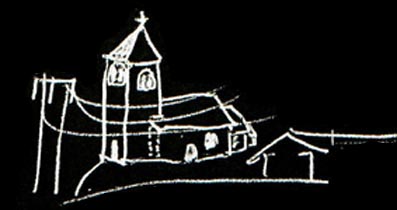
Womb Church
III:WOMB's church (built by Helena in 1130). (M.f.in 1282). It was built "after the 1140:ies" on an older outdoor site for worshipping Maria, where a wooden sculpture of her had posed on a plinth or a dolmen.
IV:SKOVDE's church (partly financed by Helena. Before it was finished, she was buried in it on 6/8 1140. 6/8 used to be "Octaua sancte Helene. Simplex" in our diocese). (M.f.as a church in 1356). Before Helena was martyred, there had circulated a rumour in 1147 of that her reliques were to wind up in Skovde's Church.
V:The ORATORY, dedicated to the reminiscence of S.Helena, near the Wombo Rivulet (founded after August 1140). (M.f.in 1373). (Eight Judges' Rings have existed pretty close to this site, erected between 600 and 800.).
VI:An oratory, dedicated to S.Elena was founded in the 12th or 13th century on the island of LUNDY, and 1325-55 it functioned as a parish-church. Lundy has the Atlantic to the west and the Bristol Canal to the east.
--25.2: MISCELLANY:
-- During the 1140:ies: ELIN
Church in Goteve parish (7 x 3 decimetres of its font still exists; see
p.1007; memorial stone raised in 1943; ruin encircled by a heavy chain
resting on plinths), Hemsio and Oreryd churches were founded. LYNGSIO
has a helenic origin, see its Well. Maybe! there was first a 12th century
Helena's Oratory near the well on yonder side of the river. Then a parish-church
was built by the O.Praem-monks in the 1180:ies, which is well-preserved
and owns a font showing the martyrdom of Thomas Becket. See p.1270-71;
20/1016-10; 25/181.
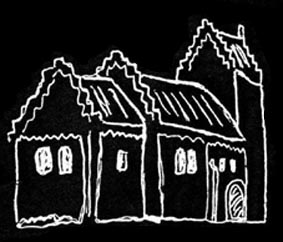
Gumlosa church
In 1192 GUMLOSA church was finished, owning until 1720 two different sets of Helenic reliques (the builders were relatives to Helena Guthormsdaughter), but they belong, probably, to Helena of Auxerre 22/5 and to Helena av Bruxelles 18/6, we're afraid. Cf 25/73-74.
During the 13th century: The churches of ELING {visited by bishop Brynolf on his way to Stavanger. "Eling is probably named after some noble lady yclept Elin - a form of Helena - who made sure this church was erected. Otherwise it is not unbelievable that the church, and thereafter the parish, have been named after the holy Sankta Elin of Skovde, raised up to the level of saints"}; HaeLLSTAD {one of the original bells was dedicated to Helena}; LUND's Sankt Helene Kirke {it is documented but not yet rediscovered in the ground of Lund. It is maybe the cloisteral church inside the Salvator Cloister, O.Praem. or more surely that of the Holy Spirit House. There existed a Saint Helena's County having its throne in Lund}; MONE alias Morene {there was a helenic well in this "parish". In the 1470:ies a 40-days-indulgentia was yielded by Hans Marquardi re this Offering-Church. Its new building was inaugurated in 1951 9/12 on the second Advent Sunday; 20/1689; 21/1789 - but noway: This church has never been helenic, and that well was dedicated to ELIAH the Prophet} and STROVELSTORP were founded.
Is the latter really a Helenic church? "Vilhelm Bang has four scanian churches dedicated to Saint Helene of Skovde, but thereanent he has no church dedicated to her west of Oresund (the Sound separating Denmark from Scania)".
After 1223 the churches of OFM. of Copenhagen and Roskilde turned helenic, and the Helena's Oratory at YSTAD was founded near her well - {well-meant hypotheses}.
Helena's Oratory at modern TISVILDELEJE was built between the 1230:ies and 1250 (maybe in 1250) by the two children of Helena Guthormsdaughter Ingeborg and Knud. 'Twas "situated slightly east of Helena's Grave" acc.to one author. Helena of Westgothia was venerated there, though, already in Guthorm Jarl's days, on 30 or 31/7. One legend claims that the oratory was built to house our saint's reliques, brought over from Skovde. Another legend claims that the O.Cart.-monks of Asserbo had "built a church by the Kilde? which soon became one of the most frequented pilgrims' goals of Denmark", (but the Kilde and the Grave are situated several stone's-casts from eachother. Then: a sculpture of Virgin Mary, Dunney claims, used to pose in a holy copse next to either sanctuary. Then: the augustinians owned the Kilde long before the carthusians arrived at Sjaelland). This oratory (actually alias Grave) was destroyed during Christian III's lifetime (1503-59). "Close to Helene Kilde there was a big stone (the visible stones of Helene Grave alias Oratory-ruin), and a woman was sitting there, who cashed in on giving each sick visitor a spoonful of earth from under the stone".
Around the 1250:ies, maybe, the church of Molltorp was founded, dedicated to Helena (acc.to Molltorp's local society) (M.f.in 1388). Its altar housed Helena's reliques from the 15th century until 1938. Within this parish there is the Hallowed Naze; also another birgittine oratory.
After 1466, 2/2, the Uppgranna gertrudian Chapel was 1/4-dedicated to Helena.
Sometime between 1930 and 1956 the MEDELPLANA church got dedicated to Helena, see below; photo 25/4. During the second half of the 20th! century one invented a S.Mary's Chapel/ Gotene parish: It's supposed to have been built by Helena within the Westerby's premises, on the Gotene Rivulet (Vesterby m.f.in 1397). One made up this spectral chapel to counter-weigh Skovde's claim on Helena, and it's made up by two elements: A)The Womb-church-legend, referred to above, of Helena having founded this church for her devotions and to glorify Mary (Since the Goteners state that Westerby was her farm, then her private Mary-chapel gotta have been erected close by). B)Helena's Oratory near Wombo Rivulet, and the using of its stones for building the juxtaposing bridge with. (The Goteners tell that their Mary-chapel too lay by a rivulet, and that its stones too have been reused for building a nearby bridge with. Now, in 1998, they are busy MOVING the Gotene Rivulet just on the spot we're discussing. A warehouse for cheese is going to be built there, and the rivulet is re-drawn in a bow around it. At the beginning of the cutting of this canal, the navvies discovered foundations of Viking Age buildings just where Helena's alleged chapel has been suggested to have lain!).
During the second half of the 20th century it was "discovered" too that the churches of RANNESLOV and YSBY are dedicated to Helena - we don't mind; we wish that ALL churches there are were dedicated to Her! And an escutcheon was designed for the ex-commune, which comprised these two parishes, exhibiting one big X and two hearts and two swords - a pastoral Aleck states that these symbols remind of Helena - "do you agree, Helena?".
In July 1993 the Elin's House of Varkumla was reported by a rose-loving pastor emeritus - an alleged and invisible helenic oratory on a height unknown. Lastly, in 1994, 28/6, inside the tower-chamber of Husaby Church, Skummeslov's Church was reported to be helenic by two friends of the Aleck above.
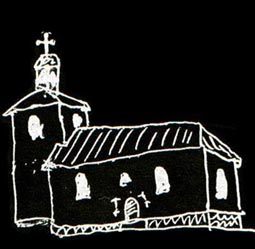
Haellstad church
25.3:Not only HAELLSTAD church has been connected to Helena for onomatopoeic reasons, but also the medieval ex-church of Elin, which parish in 1546 got integrated into Goteve: Their local tradition tells that Elin's Church was built "for the memorial of the sad incident, that Helena had been slain [thereabouts]". Furthermore Eling is regarded as being namned after our saint, as well as plenty of farms in the different parishes which own an image of her in the church. Hallekis in Medelplana parish is supposed to have inspired the naming of one of its wells "Elin's Well" well before 1898!, and between 1930 and 1956 it was "detected" that Medelplana church near Elin's Well was dedicated to Elin/Helena and to Appollonia. Some informers maintain that there's another Helena that has caused the helenic altars, dedications and reliques in at least Gumlosa, Copenhagen, Lund and Roskilde - yea, in the entire Scania-Denmark region.
25.4:There are three AELINE-names in our district: AL, ALHS = pagan temple, VINI = meadow. The meadow has belonged to or lain next to a temple or an offering-site. Alwine became Alene, which became Aelene close before 600, which in turn became Eline. "A helenic cult can not be detected in any of the places, which names resemble Helena/Elin. All HELDE-farms eg. seem to have developped from HIRDs (royal guardians), who might have owned those farms. Helena's Well at Gotene is 300 years older than the farm there called Helde."
A)ELING in Barne District, pronounced "Ili", firstly mentioned in 1443 (Eline).
B)ELIN in Vilske District, pronounced "Ilum", f.m.in 1403 (Elina Sokn).
C)Elinae Mark(grounds), Elinaemarks Kulle(hill), Elinae Skog(forest) and Elins Kaella(well) in Kakind's District. On Elin's Grounds (Champs d'Hélène) rites were performed by Helena's Guild. On top of Elin's Hill, eg.yclept Elin's Masses' Hill, her Masses were held. Bishop Brynolf #1 wrote in 1281 "I Skodwe Um Aelinaer Maessu", stressing that Aelina is a woman's name through the genetive -er, and that it's NOT a territorial name. "Saint Mark's Well" lay at the eastern basis of this Hill, not namned after a saint but after Elinae Mark! Elin's Forest was not an oaken one - it was bordered by such - but in the small remains of it today, oaks are dominating (near the crossing of Sodra Bergsvagen/Vadsbovagen). The forest was maybe firstly planted or owned by Helena - her estates lay where the core of Skovde City is, and its name was Eline? Elin's Well is described above.
25.5:
WELLS HAVING CONNECTION TO HELENA:
"It was Helena's body that hallowed
the water in the wells; it was not holy water that hallowed her!" one
informer claims, and another adds that "Wells broke forth whereinsoever
that Helena set her foot on the ground". Sister Jessica (O.Hel) remarks
that, in the helenic parishes of Wattlosa and Gotene, the bride had to
take a purifying bath in connection to her wedding - the water was brought
to the church in a 'nuptial vase' from A HOLY WELL.
--IN SWEDEN--
I:The one at GOTENE (broke forth 1/8 1140; documented firstly in 1462; removed and became a fountain early 18th cent. Dried out in the 1950:ies; now represented by a monument on the industrial site of Gotene Diary. The water is municipal, and its pressure is enough to make it a small fountain by means of a nozzle. The brynolfian legend of St. Helena is somewhat obscure as to where her primary well broke forth, but the legend does not say that a well did so when and where Helena was martyred. The written proof* of her well at Gotene of 1462 indicates that the well was dedicated to her, but not whether it had broken forth when and where she died. The connexion beween the site of her martyrdom and her well at Gotene is doubtlessly of post-catholic time, and an early 20th-century saga-publisher writes "After her return, whenas she intended to go to the church of GOTHEM, she was attacked on the road by these /her old enemies/ who killed her recklessly... On the very spot, where this had occurred, a clear well gushed up. And this, and that other miracle, contributed to that Mrs Helena subsequently was canonized") *This proof has proved to be unprovable, alas, since it evidently was invented by Benzelius in 1708!
II:The one by the Wombo Rivulet beneath the bridge on the site of the Panzer Regiment at Skovde. (broke forth 5/8 1140, and has no connexion to where she was martyred). There are 6 bridges near this well. 1.built 1759 with stones from the Oratory. 2.built in the 1960:ies as a successor to #1. 3.a military, provisional one. 4.one suspended one, high up over the rivulet, built for military education, forbidden to enter (acc.to unreadable signs). 5.A low, suspended one, built for historical reason, leading to the well (close to the ancient ford under bridge #1, modelled after the famous drawing) - it was destroyed by floating ice in 2000, and in 2001 it was removed and instead STEPPING-STONES were placed in the rivulet itself. 6.made for pedestrians out of two big concrete pipes.
III:The Well of Elie of offering within the protoparish of Mone, mentioned in writing e.g. in 1812 and 1916: Two or three famous sources lie a stone's cast from it, across the borderline of Haellstad on the premises of Hov Farm. In the 13th century one of the bells hanging in Haellstad Church was baptized in Mone's helenic well. The well hasn't changed name - it has only been confused with the 2 or 3 sources just mentioned. A stone's throw from the Well of Elie there's a boulder, cloven identically like the Rinsing-Boulder of Skovde - and this "natural copy" mustn't be confused with the Tingsten (a border-mark) nor with the stone having a holey top. "One regarded Helena as the guardian of this well, and its water cured eye-diseases" - very funny, since "Elie" is dative of Eliah, not a form of Helena!, first used 3/2-1279.
But more surely this Well of Elie rightly is the only well of Mone, positioned in Mone parish like it should: 85 m west of a road, centrally in a sloping pasture north of the tall church hill, 2 x 2 yards wide, pouring towards northwest, having a rock of 2 x 3 yards on the north-east side - that rock was meant to demolish the church once, but the giant who threw it, missed it and the well was created where the rock landed. Cattle still drink from this well of St. Eliah.
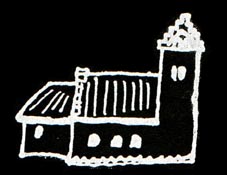
Lyngsio church
IV:LYNGSIO in Gards District: Near the northern foundation of an ex-bridge, south of a starch factory, there is the only scanian helenic well there is. Its Helenic Oratory lay alone on the southern banks of the river. In 1924 one thought that this well was named after Constantine's mother, but in 1935 one realized it was named after Helena of Westgothia.
V:West Vram in the same haerad (district) as Lyngsjo (Gards), at Ullarp N:r 1, on the slope of the Ridge towards Vram River: Helle Kaella. Owns a wooden cross. IV: and V: lie close to the O.Praem.cloister of Vae.
VI, VII and VIII: three uncertain wells: At Barum in Kiaby parish, close to O.Praem.cloister of Baeckaskog: Helena's Well. There's a coin-box as in Tisvildeleje. And Leena's Well in Alseda parish at or on a cliff by Leena Farm. And 1/4th of the well of Gertrud's Chapel at Upper Granna became helenic in 1466.
IX:At least some decades before 1898 the Elin's Well in the ditch beneath Bo's Farm in Medelplana parish was known - it's wrongfully claimed to be from 12th century: "On a sunny sunday in 1898 we walked up to the country road and passed Elin's Well; long ago, as long as people believed in miracles connected to wells, I guess it was regarded, along with other wells of hers, to be health-generating". Photo 19/1451.
X:One well is claimed to belong to Elin's House - a circular ruin of something, immediately west of Varkumla churchyard - notified in July 1993.
XI:An ex-Gertrude-of-Nivelles' Well was reinaugurated by a protestant pastor on 6/11 1993 as Helena-of-Westgothia's Well infront of Ranneslov's Mill. The stone-layers at its bottom are medieval. This work done by the owner of Ranneslov's Mill is very good and unusually praiseworthy. We know of no-one else who has done anything similar for Helena's cult during the 1990:ies!
--25.6: IN DENMARK--
I:Assens/Fyn, Odense Amt, north of Assens, "Sankt Helene Kilde #856" on the very beach on the west side of the island, on Lilla Belt, 38 km from Odense. The source "pushed a boulder away from it".
II:Grinderslev Parish, Viborg Amt, Salling Northern Herred, "Helene Kilde #1653.1", a stone's throw east of the parish monastery, north of the road to Langesgard.
III:Halsted p., Lolland, beside Maghoj Kilde not far from the 13th century OSB-monastery of the parish; "Helene Kilde #742.2".
IV:Hammer p., Aalborg Amt, Kjaer h:d, 300 m south of Prestgaarden; "Sankt Helene Kilde #1469".
V:Helsingor, close to Kronborg Castle, "Helle Laene Kilde" - it is not included by August Schmidt in his well-inventory, and its "existence" is probably due to errors; its name does concern the Helenic source at Tisvilde - how far "close to" is, is namely subjected to individual references!
VI:Mariager's Rural Parish, Randers Amt, Onsild h:d, south of the forest of Himmelkold, on the north slope of a hill; "Sankt Helene Kilde #1851.1". The nunnery of Mariager was started in 1430, 23 km north of Randers City.
VII:Nodagers p., Randers Amt, Djurslands Sd:h:d, at Pederstrup, mentioned in 1743 as "Sankt Helene Kilde #2031.1".
VIII:Orting p., Aarhus Amt, Hads h:d, "Sankt Helene Kilde #2139.1", halfways up a slope on the east side of a hill, in the suburb of Halen.
IX:Ruds Vedby p., Holbaek Amt, Love h:d, "Helenes Kilde #284.2", on a steep hill upon Galgemarken - the Grounds of the Gibbet; mentioned in 1758.
X:Stillinge p., Soro Amt, Slagelse h:d, "Helene Kilde #435.2", on the premises of Keldstrup at a stone's throw from the village.
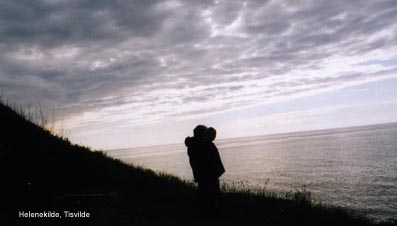
XI:Tibirke p., Frederikborgs Amt, Holbo h:d in Sjaelland, "Sankt Helene Kilde #32.1", 800 m north of the fishermen's old waterside shacks. A letter from 1194 shows that this well (Kilde) belonged to the monk-cloister of Aebelholt, OSA. Already during the 1160:ies it was dedicated to Saint Helena of Westgothia. Its oratory (Grave) at Tisvilde was built in the 1230:ies and 'twas destroyed in the middle of the 16th cent.. One version of the story of this well reads that had Helena lived there for a period of time on the Meadow nearby, inasmuch as she was on the run from a potentate in Sweden who had wooed to her - when she had declined the offer, he had chased after her from Westgothia all the way down to Scania. People sought her thereafter on the Meadow at Tisvilde for her Wisdom's sake. It is also said in respect of this well, that "this was maybe the same well, that during the Middle Ages was dedicated to the swedish female saint Helene..."; "a serving-maid, 14 or 15 years old, who suffered from an eye-disease, betook herself to Helene Kilde in three succeedant years in order to be cured, and she was". During the Catholic Era the recommended period of visiting Helene Kilde was extended from Midsummer unto her Feast, id est it lasted from 23/6 to 31/7. Then: Any time of the year, in the evenings(?), one can visit the oratory (Grave) by the holy Kilde Three Thursdays In A Row in order to achieve the same healing and power as during the mentioned period, viz.through performing devotions there.
XII:Tybjaerg p., Praesto Amt, Tybjaerg h:d, "Sankt Helene Kilde #563", on the premises of Tybjaerg Gaard, by the so-called Kirken, "church".
XIII:Vorup p., Randers Amt, Galten h:d, in a paddock at Strommen Station, "Sankt Helene Kilde #1921".
AND:The well named Tofte Kilde "next to the forestal meadow close south-east of Tibirke Church" must be added here, since it is mentioned in connexion to Sankt Helene and Tisvilde, and this well was the reason to why Tibirke Church was established where it was (viz. in the 1120:ies).
25.7:Lastly there was before 1740 one holy helenic well on the NORWEGIAN westcoast island of Torget en face de Bronnoysund, and there are maybe one or two more helenic wells on other norwegian islands. "St. Helenes Kilde paa Torget havde allerede ved 1740 tabt sit Ry for Hellighed (written in 1744 in Norway)".
25.8:Then of course one mustn't forget GA Wells, who has presented a likely theory on the Origo of Christianity - that Jesus never was a physical being; that he was invented, and that his redemptive function was modelled after the earlier and eternally valid Redemption given to human beings thanks to HELENA, the First Thought of God.
***26...Liturgically Helena is mentioned at 4 cloisters, and today she's included in the official Swedish Litany and, as S.Elin of Skovde, in the Catholic Book of Mass...
26.1: LITURGY:
(After Pater Noster of the Mass of
the ancient Scara Diocese there followed Libera Nos: "... intercedente...
Maria et electo Michaele arcangelo tuo et beata et gloriosa sancta tua
Helena et beatis apostolis tuis Petro et Paulo atque Andrea ..."). Helena
is included liturgically in : A)Litanies from either Gudhem's or Varnhem's
OSB-Cist. cloister, along with Sunniva. B)Her Gospel-text was first Matth.12:26-35;
then, in the days of bishop Brynolf #1, Matth,12:46-50, and nowadays it's
Matth.10:28-33 re Elin's Mass 30/7. At Alvastra Brynolf found a written
Helena-text according to his own canonization process. C)Brynolf's liturgical
text, written 1281-88. D)Calendars of 1250 and 1350 in Strengnes Diocese
and by the OP.of Aabo respectively. E)Calendars of Scara Diocese of 1350
and 1498.
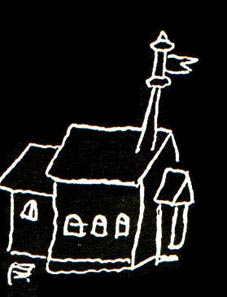
Hemsjo church
F)All-Saints-Litany of Scara Diocese, introducing the Mass of that day, included Helena along with Sunniva. G)A 15th century psalterium of Scara Diocese, along with Sunniva. H)Litany from HEMSJO (its Manual) of the 15th cent. - this is where Hemsjo enters the helenic scene - but already during the 14th cent.she was included in the litany of this church; 17/1354. I)A calendar from Mariager's Cloister. J)At Aebelholt's Cloister (OSA), every tuesday from 1512 and onwards, an helenic Collect would be prayed. (The abbot there mentioned in a letter of 1194 Queen Helena - she was widow, badly wounded after an assault; the mother of S. Niels and S.Valdemar, and she died at VRETA nun-cloister in Linkoping Diocese). K)Litany #466 in present Orémus. See for more info Eugendus on 30/7-6/8.
***27...On the first Saturday of August in 1164 pope Alexander III (born in 1105; pope in 1159; lived exiled at Sens 1163-65; defunct 30/8 1181) in the Cathedral of Sens, which was still under construction, made Stephanus of Alvastra the first archbishop of Sweden, in the presence of e.g. Eskil, the archbishop of Denmark. Alexander III canonized altogether Giovanni di Meda (1159?; allotted day: 26/9), Guarinus (1159?; 6/2), HELENA OF SKOVDE (1164; 31/7), Thomas Becket (1173; 29/12), Bernhard of Clairvaux (1174; 20/8) and Galganus (1181; allotted day: 5/12) after he'd decided to make the pope sovereign as to canonizing - the decision was a reaction against the heretic measure of the folks of Upland to venerate a drunkard as a saint - the phoney king errorc or eric.
A document written by Al in Sens re the canonization of Helena was read aloud in the cloisteral church of Alvastra during the fall of 1164 (after August but before 1165) by archbishop Stephanus, but she was not elevated - this procedure wasn't yet invented. The canonization of Helena did thus NOT take place inside her church of Skovde, but this fact will hardly get rooted and the wrongful belief will hardly get uprooted, will it?
"Much later (certainly not during 1165!) Helena's reliques were laid into a silver Shrine in an ambitious ceremony with long monotonic lessons," (free fantasies by a 18th cent. pastor, adjusted to fit Helena's Church in Skovde) "St.Elmo's Fire sparkled at the tips of the metallic crosses on top of the towers, [a phenomenon] thenceforth called St.Helena's Fire" ... "and the Shrine was set into a vaulted niche somewhere in the north-east part of the church, measuring 1 x 1.5 x 1.5 yards. A cast-iron Grating of very complicated structure (it's still there in S.Helena's Church) was mounted infront of the niche in the 15th century". "Double doors with double locks were hung infront of the Gate. Monks promised to guard the niche". "Reduction in Purgatory was granted for those who yearly would visit S.Helena's Mass and also contribute to her Church's finances"....
27.1: ON STEPHANUS
& SPECULATIONS ON THE CANONIZATION OF HELENA:
"Not only Brynolf got helenic information at Alvastra (1288) but also
Stephanus (before 1164), which text maybe was written in french, since
it was written in Sens in France. Stephanus' visit to pope Alexander III
there is a historical fact, and Stephanus became our first archbishop
in Sens' Cathedral on the first saturday of August in 1164. During the
19th century the following was written, and almost all of it is pure but
lovely nonsense. No elevations occurred until after the early 13th century,
and that her canonization could not have been realized until after August
of 1164: "30/7 1164 the fragrant bones of Saint Helena were lifted up
from the grave in the main choir (the church and her grave were not finished
in 1140, so between 1140 and 1164 her body was lying in a provisional
grave at the main choir. That the church was built in between 1137-64
is fully possible) and were laid into a silver coffin, which was elevated
up on the altar. After the order of canonization, written by Alexander
III, had been read aloud, the coffin was placed in the grave that she
herself had designed. Thereafter Masses were to be held at her grave".
A catholic dictionary gives the odd piece of info, that 8 english miles
from Copenhagen, Helena was enshrined in a church dedicated to her.
27:2: A 15th century entry re Helena's canonization: Anno domini millesime centesimo sexagesimo tercio consecratus est... stephanus... nacione anglicus... canonizauit... Sanctam Helenam in Skedwe... (Reg. lat.525 in the Vatican Library; copy chez KB/ Stockholm; cf Script. rer. suec. I:1, p.51, 61-62).
AND
27.3: SAINT HELENA's FIRE: is an Elmo's or Eliah's Fire, having a single flame, which emanates from the points of eg. churchtowers, masts, due to electronic and meteorological tensions.
AND
27.4: THE FLOOR OF THE CHURCH: Believe it or not - "the floor inside Helena's Church in Skovde is more than one yard above its floor of the 12th century". If this is true, it's no wonder that they failed to localize that Niche of Helena's Grave during the last renovation - they didn't search low enough!
***28...Ecclesiastically the 30th of July is the Feast nowadays of "Elin of Skovde, martyr". Like we've given you a glance of above, Brynolf #1 (1245-1317) started in 1281 to reactivate the then 141 years old Helenic Cult, whenas he enhanced and glorified her Mass meant for, in the diocese of Scara, 30/7; elsewhere for 31/7. (Her Feast could not be "translated"). And after the 11th Miracle he wrote a liturgical text to her Mass during the fall of 1288 - to the Rose of Westgothia, the Torch of our Ancestors' Land. He based the text on local and oral tradition, and on another and simpler legend...
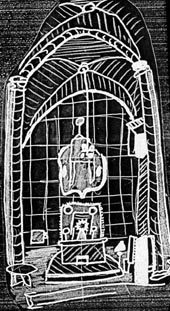
Bishop Brynolf Algotsson's chapell, Scara
28.1: ON
BRYNOLF ALGOTSSON:
Bishop Brynolf #1 was born in the 1240:ies on Hasthalla Farm in Skallmeja
parish? In 1266 he departed for studying at the Varsity of Paris (founded
in 1120) and there he might have acquainted Elene of the Mykene-family,
bibliographically at least. In 1278 he was elected bishop of Scara. In
May 1279 he attended, beside king Magnus Ladislaus, the meeting on Alsno,
and in October 1279 he attended the synod of Talje. In 1281, 141 years
after Helena's martyrdom (1/8 1140) he meliorated her Mass - to wit, he
had discovered her long before the summer of 1288, whenas he studied her
at the cloister of Alvastra. (In Dipl. suec.709:4 he mentioned in 1281
Aelinaer maessu in Sködwe, and also Botulf's maessu and pancrasz
in falukopungi; halldraehaelghunnae day (all saints), laurinszaer and
sanctae michiae's days). Sister Jessica (O.Hel) writes on his helenic
texts: "...as a matter of fact there are traditions on S:ta Elin of such
characteristics, that it is not at all impossible that they are older
than Brynolf's version of her legend". An older helenic legend had been
lectured and had been used as a thesaurus delivering ideas for sermons
before Brynolf's time, on Helena's Day, and on this foundation Brynolf
kept building: "Helenam sanctam viduam quam presul inuocauit historiam
per congruam decenter honorauit" - with a fine narration he honoured the
holy widow Helena, whom he'd called upon for help.
28.2:In 1282 he received Jón Roede, the archbishop of Nidaros. The Helenic Cult was thriving at Alvastra Cloister, i'faith, where Brynolf (in the summer of 1288) was able to study the sketch of the document for Helena's coming canonization. He visited, in the evening of 14/8 1288 Her church in Skovde and Her Reliques. In 1290 his uncle Thorner Cryda was liquidated by his own servants in a similar way and under resembling circumstances that Helena's son-in-law had been done away with. In 1298 Brynolf founded a bishops' fortress on the ruins of the redoubt that Magnus Barefoot had constructed on the island of Kolland close to 1100 - the Lacko Slott (Castle)-to-be. Brynolf's buildings burned down, though, in the 1470:ies.
28.3:In 1299 he bestowed the estates in Womb Parish, that he had inherited from his mother - she had "owned all Womb" - upon Scara Cathedral. In 1304, 2/9, at Lodose, Brynolf was endowed with a Spine from the Crown of Thorns that Jesus had worn, by a messenger from Haakon Magnusen, the king of Norway. The spine had originally been found by Constantine's mother Helena - it takes a Helena to make such a find! Brynolf carried shoelessly this Relique to Scara's Cathedral; he encapsulated it with molten glass which solidified into a sphere and mounted it so that two angel figurines held the sphere, and he wrote a liturgical text for the Spine!
28.4:Brynolf died in 1317, 6/2. Some of his seals are preserved, and his pilgrim's Badge is attached to the lesser bell of Lindarva Church. In 1349, 2/2, Mrs Brita sensed that sweet smell which factually exists inside the east portion of Scara's Cathedral, and she attributed this to Brynolf, whose grave presumptively was in the Crypt "among the swines". His present Day is his day of beatification in 1492 - 16/8. His beautiful "chapel" inside the Cathedral is to the left of the AWFUL retable in the main choir, but one of these days they'll dismantle Brynolf's chapel due to a renovation of the cathedral - {yes, it is gone now}. His actual grave has been unknown since the 1590:ies, though.
***29...At another Helenic Feast one blessed the seeds or crops in her Oratory on Wombo Rivulet. A processionary Cross and her picture were carried around in the fields too...
29.1: ON THE MONDAY BEFORE CHRIST's ASCENSION DAY: that's when the service in Helena's Oratory near Skovde was held, in memorial of her.
***30...We claimed that monks, before 1314, composed and produced the Seal (made of lead or tin) of Skovde, which comprises a true image of Helena and her signature, symbolizing that she, during the 1130:ies, founded this Megalópolis - where the outskirts of seven large estates met. (Some geezers of today claim, without any trace of reason, that Skovde received its privileges in 1399)...
30.1: OUT
OF SEVEN COMPLETE ESTATES,
held by termors, given by Helena to
the pioneer citizens, the City of Skovde was established (1130:ies). There
were seven agrarian units, small villages, around the growing Skovde:
Hasslum (firstly mentioned in 1415), Havstena (fmi 1396. Called a Village
with a church in 1495, 8/12), Horsaas (fmi 1356), Hargustorp (a SINGLE
FARM, mentioned only in 1540, and therefore wrong and it must be replaced
by the correct Hene Village, which existed before the age of vikings and
which was situated on the plateau west of the Alva Source; owned a large
oak forest. The youngest graves of its grave-field are from 1050!), Kapplunda
(fmi 1413), Risa (fmi 1393) and Segerstorp (fmi 1326; totally wiped out
in 1992, 29/1). Two other neighbouring villages were Ryd, which church
was depicted in 1655 but 'twas gone before 1659; and Asbotorp, which is
one of the oldest farms around here, and it's unique through being the
only medieval farm lying on top of a flat-top-mountain.
End of PART TWO
Continues in Superhelena Part Three.
Back to Superhelena Part One
Superhelena
Illustrated version:
Superhelena1
Superhelena
2 Superhelena
3 Superhelena
4
Appendix to part
4: Helena Dialoque
Contents
English
version
Non-illustrated
version: Superhelena
1 Superhelena
2 Superhelena
3 Epitome
Brynolf
Algotsson
about Helena, 1288
Innhåll
Superhelena svensk version
Superhelena
1 Superhelena
2 Superhelena
3
Brynolf
Algotsson om Helena, 1288 Sankt
Appollonia
Översättning af Joseph Dunney: Saint
Of The Snows
Albany, New York 1937 Snöfallens Helgon:
Förord
Dokument 1
Dokument
2 Dokument 3
Efterord
* * * * *